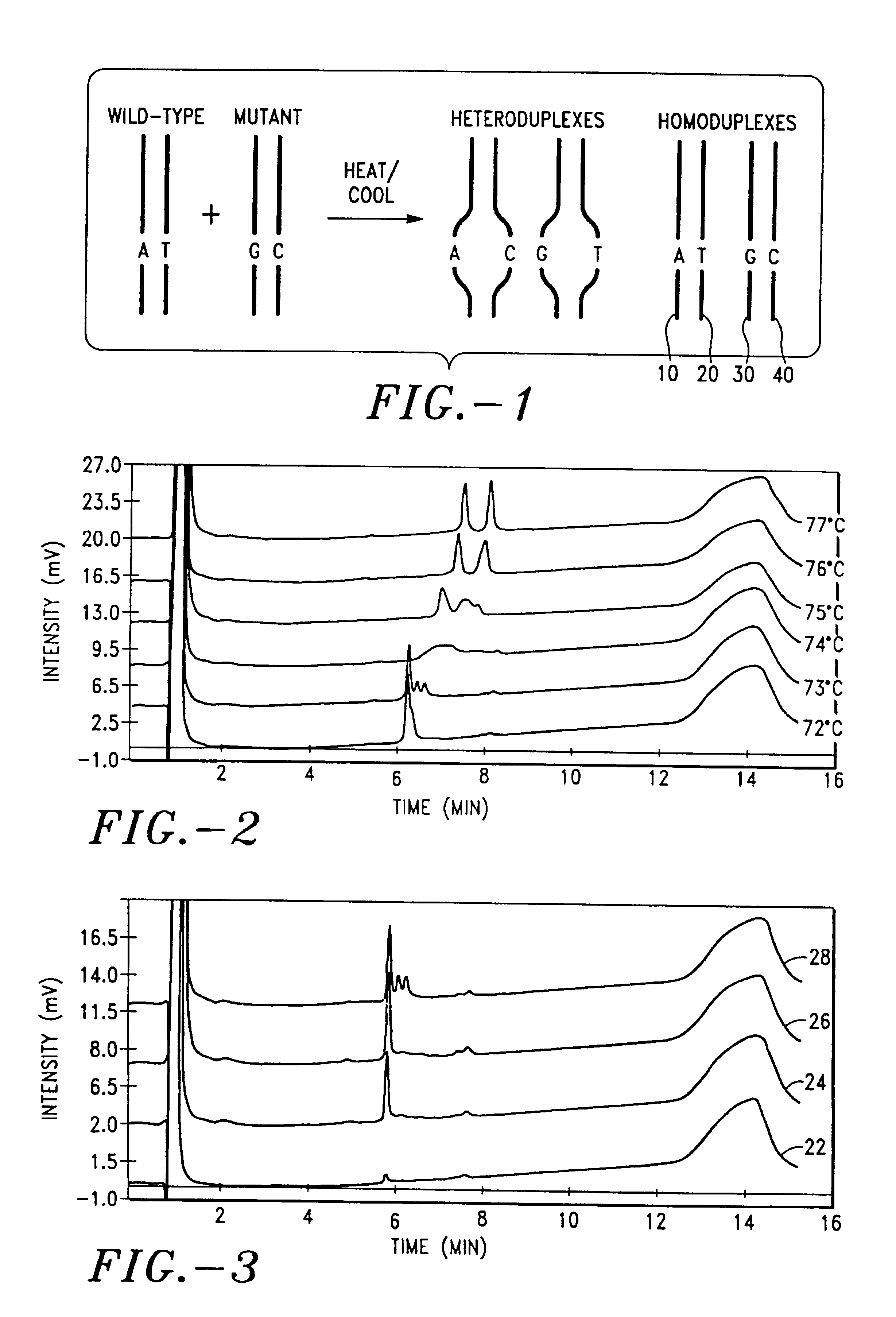Detection of nucleic acid heteroduplex molecules by anion-exchange chromatography
a chromatographic method and nucleic acid technology, applied in the direction of anion exchangers, amphoteric ion exchangers, immobilised enzymes, etc., can solve the problems of stranded dna offspring containing a heritable difference, altering its function, life-threatening or fatal, etc., to achieve rapid results, reliable operation, and convenient use
- Summary
- Abstract
- Description
- Claims
- Application Information
AI Technical Summary
Benefits of technology
Problems solved by technology
Method used
Image
Examples
example 1
General Procedure
[0148]Oligonucleotides and polynucleotides may be obtained by polymerase chain reaction (PCR). In this case, primers are selected flanking the sequence of interest and amplification of the oligonucleotide / polynucleotide of interest is carried out by standard procedures (Mullis, U.S. Pat. No. 4,683,202, issued Jul. 28, 1987; Mullis et al., U.S. Pat. No. 4,683,195, issued Jul. 28, 1987). Source nucleic acid for the oligonucleotides of interest may be RNA (Kawasaki, et al. in PCR TECHNOLOGY: PRINCIPLES AND APPLICATIONS OF DNA AMPLIFICATION (H. A. Erlich, ed.) Stockton Press (1989); Wang, et al. in PCR PROTOCOLS: A GUIDE TO METHODS AND APPLICATIONS (M. A. Innis, et al., eds.) Academic Press (1990)) or DNA.
[0149]“HOT START PCR” can be performed (D'Aquila, et al.) using standard techniques (“AMPLIWAX”, Perkin-Elmer Biotechnology, Norwalk, Conn.) in order to make the PCR amplification more robust for amplification of diverse sequences, which ideally require different ampli...
example 2
PCR Protocol to Amplify the A and G Alleles
[0160]Nucleotide position 168 within the 209 bp STS is, sY81, polymorphic in humans, and is either an adenine (A) or guanidine (G) base (Seielstad, et al.). Both the A and G forms were initially subcloned from human genomic DNA.
[0161]Plasmid A was obtained from Kramel Biotech (catalogue no. 033740, batch 2797133, Division of Transgenomic, Ltd., Cramlington, Northumberland, UK). Plasmid G was also obtained from Kramel Biotech (catalogue no. 033840, batch 2797236). Plasmid A was a pPCR-Script Amp SK(+) cloning vector (available from Stratagene, catalogue no. 211188; GenBank® database Accession no. U46017), having the A allele form of the 209 bp insert positioned at the Srf I site. Plasmid G was a pPCR-Script Amp SK(+) cloning vector (Stratagene), having the G allele form of the 209 bp insert positioned at the Srf I site.
[0162]Synthetic oligonucleotide single stranded PCR primers 209-F (SEQ ID NO:1) and 209-R (SEQ ID NO:2) were used to amplify...
example 3
Mutation Detection Using DAEHPLC
[0176]This Example refers to FIGS. 2 and 3. For the G allele and A allele, a 3 μL sample of the amplification product from Example 1 was injected onto an anion-exchange HPLC column (100 mm×4.6 mm ID). The column contained diethylaminoethyl functionalized polyacrylate (Gen-PakTM Fax, part no. WAT015490, lot no. T82271, Waters Corp., Milford, Mass.). For analysis of the product of the hybridization procedure from Example 2, a 6.0 μL sample was injected. In FIGS. 2 and 3, buffer A was 20 mM Tris-Cl (pH=8.0) in 15% acetonitrile (Tris-Cl and acetontrile were from JT Baker, Phillipsburg, N.J.). Buffer B was 2M choline chloride (Lancaster, Pelham, N.H.) in Buffer A. The chromatography was monitored 260 nm using a UV detector. The column was eluted at 73° C., at a flow rate of 0.75 mL / min, with the following gradient:
[0177]
Time% B0500.150107010.11001310013.1501650
[0178]The HPLC system (WAVE® DNA Fragment Analysis System from Transgenoic, Inc.) included the fo...
PUM
| Property | Measurement | Unit |
|---|---|---|
| diameter | aaaaa | aaaaa |
| diameter | aaaaa | aaaaa |
| column temperature | aaaaa | aaaaa |
Abstract
Description
Claims
Application Information
 Login to View More
Login to View More - R&D
- Intellectual Property
- Life Sciences
- Materials
- Tech Scout
- Unparalleled Data Quality
- Higher Quality Content
- 60% Fewer Hallucinations
Browse by: Latest US Patents, China's latest patents, Technical Efficacy Thesaurus, Application Domain, Technology Topic, Popular Technical Reports.
© 2025 PatSnap. All rights reserved.Legal|Privacy policy|Modern Slavery Act Transparency Statement|Sitemap|About US| Contact US: help@patsnap.com

